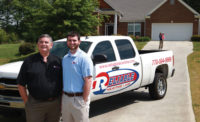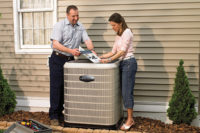If the ice machine is undersized or needs a good cleaning, the customer will likely run out of ice when it’s hot. Of course, the customer says something is wrong with the machine or that it never runs out of ice and therefore must be broken.
Their complaint is, “It’s making ice, it just won’t keep up.”
This is definitely the most common call in the hot summer months.
How to handle it
To attack it, first do a quick visual inspection of the unit. Look for a lack of normal maintenance that can seriously affect ice production.It is important to remember that preventive maintenance (PM) really pays big benefits towards better efficiency and maximum production.
Generally, manufacturers recommend a PM schedule that includes cleaning the water system with an acid-based ice machine cleaner and sanitizing to eliminate bacteria. Additional PMs may be required in bad water areas.
Cleaning instructions are usually located on a cleaning label and/or in the instruction manual that comes with the unit. Be sure to follow the instructions and use the cleaner recommended by the manufacturer, as this will protect a plated-type evaporator from damage due to harsh chemicals.
PM checklist:
- Check water system and evaporator for scale buildup. Clean as necessary.
- Check for talc or mineral buildup in reservoir. Remove and flush thoroughly.
- Check pump motor operation. Look for a broken impeller or slow pumping.
- Check water flow through the external water filter (you’re looking for low water flow to unit).
- Check strainer, inlet water valve screen, or float-valve (if used) for obstruction.
- Inspect float valve assembly adjustment and operation (if used).
- Check air filter and condenser fan blade and coil for dust and grime.
- Check for proper drainage or water backup in the bin that can melt ice away.
- Inspect the water overflow of the reservoir that washes ice away.
- Check the bin control for proper location and operation.
Size or dirt dilemmas
Once you have inspected the unit and cleaned it as necessary, determine if there really is a problem by conducting a production check.This will require you to time a complete cycle, from the beginning of one freeze cycle to the beginning of the next. You will need to catch the ice produced during this cycle and weigh it.
The formula for checking ice production is simple. Divide the cycle time (in minutes) into 1,440 min to get the number of cycles the unit will run in a day. Then multiply the number of cycles by the ice drop weight (in pounds) for the total ice production in 24 hrs:
1,440 ÷ Cycle time x Ice drop weight = Production/day
While you are waiting for the cycle to complete, check the manufacturer’s data on that specific model number to determine what the production should be. Data charts are generally available to show production, ice drop weight, and approximate cycle times under a variety of conditions.
(Many manufacturers readily provide this type of data in a small technician’s pocket guide format.)
You will need to know the incoming water temperature and ambient temperature around the unit to cross-reference the data chart.
Once the production test is completed, compare the results with the manufacturer’s data. If the amounts are close, that is likely all of the ice that will be produced by that machine in one day.
Melting away?
At this point you will want to discuss where the ice is going.Determine the approximate ice needs by asking a few questions. Make a list of what the ice is used for and the approximate amounts. Add a 25% fudge factor and compare the needs to the present supply.
If the production is inadequate, seize the opportunity and make that sale.
It is possible, however, that the customer may have the appropriate machine production and not enough storage to get them through the hot days. In this case, there are usually two choices. They can bank ice in bags in their freezer for the hot days, or change to a larger storage bin.
If the production is not within the manufacturer’s specifications, it’s time to check the refrigeration cycle.
Ice machines have a critical charge system for maximum ice production. The refrigerant type and correct charge are usually listed on the unit nameplate.
Most ice machines use a standard thermostatic expansion valve system. The key to proper production is proper cycle times. The freeze and harvest times should closely match the manufacturer’s specifications for the air and water temperatures at which you are operating.
Remember that while all ice machines perform the same function, the operational sequence will vary between manufacturers. Cycle times will also vary. Some manufacturers prefer long cycle times while others prefer short cycle times. Know your products well enough that you can spot a problem if it exists.
Refrigeration system checks:
- Read nameplate charge type/amount and weigh in correct type/amount.
- Check system pressures against manufacturer performance data.
- Inspect the evaporator’s frost pattern and freeze cycle time for proper TXV operation.
- Check ice fill on the evaporator. Look for full, normally shaped cubes from top to bottom.
- Check compressor efficiency by compressor manufacturer’s amperage curve. (Pump-down method is not recommended.)
- Check the hot gas system for proper operation (no hot gas leak-by).
- Look for proper operation of additional refrigeration components (headmaster valve, bypass cooling valve, liquid line valve, etc.).
- Look for proper pump motor and fan motor operation. Once the problem is identified, use proper refrigeration practices to repair it so that your customer will be back in the ice business at maximum capacity.
Sidebar: New home warranty program lets consumers choose contractors
CHICAGO — One of the biggest drawbacks to most home warranties, from both the homeowners’ and contractors’ perspective, has been that the homeowners have been limited to choosing a service contractor mandated by the warranty carrier. If the homeowner was already comfortable with another contractor’s work, the warranty program wouldn’t take that into account.Enter the CNA Home Warranty, which offers home warranty coverage to consumers through the independent insurance agent network, either in conjunction with the purchase of a CNA homeowners policy or on a stand-alone basis.
It provides coverage for the breakdown of mechanical systems and appliances in the home, including air conditioning and heating units, water heaters, electrical, plumbing, washer, dryer, dishwasher and range.
“The CNA Home Warranty is unique in that the homeowner has the flexibility to choose the service for necessary repairs, or alternatively, we can recommend a local service provider from our network,” said Robert C. Ritchie, executive vice president, CNA Warranty.
The warranty provides coverage for the repair or replacement of covered appliances and mechanical systems caused by normal wear and tear. Coverage is provided for both parts and labor. There are also no coverage limitations or premium adjustments due to the age or square footage of the home.
The warranty offers a selection of coverage and payment options. Two types of plans are offered with optional coverage for well and septic systems, ranging in price from $199 to $363 annually.
For more information, contact CNA Financial Corp., CNA Plaza, Chicago, Ill. 60685; 312-822-5000.





